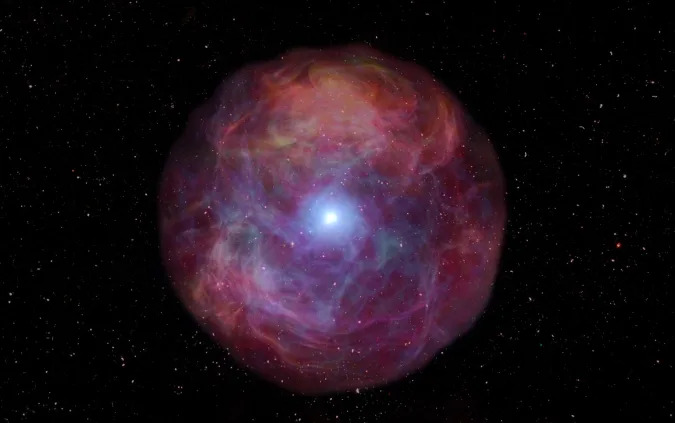
Supernova SN 2020tlf observed by the Keck Observatory in Hawaii. (Image Source: Keck Observatory)
By Glenn A. Walsh
Reporting for SpaceWatchtower
A rare Supernova, registered as SN 2020tlf, has been observed by astronomers. A Supernova is a powerful and luminous stellar explosion, when the original star either collapses into a neutron star or black hole, or is completely destroyed.
The progenitor star was a Red Super-giant, the largest type of star in the Universe in volume (but not, necessarily, the brightest or most massive of stars); such stars are hundreds or even more than a thousand times the radius of Earth's Sun. And, this is the first time scientists have been able to
observe a Supernova event before, during, and after the event! The Supernova observations were reported in a new study in the January 6 issue of the Astrophysical Journal.
"This is a breakthrough in our understanding of what massive stars do moments before they die," said lead author Wynn Jacobson-Galán of the University of California Berkeley. "Direct detection of pre-Supernova activity in a red supergiant star has never been observed before in an ordinary Type II Supernova. For the first time, we watched a red supergiant star explode!" (quote from a public statement reported on https://keckobservatory.org/dying-star)
In the Summer of 2020, they detected the Red Super-giant star that was about to Supernova, using the University of Hawaii Institute of Astronomy Pan-STARRS 1 telescope in Maui, Hawaii, due to the large amount of light the star was emitting. In the Autumn of 2020, scientists captured the Supernova explosion using the Low Resolution Imaging Spectrometer (LRIS) of the W.M. Keck Observatory on Mauna Kea, Hawaii, including the Supernova's first spectrum.
While most Red Super-giant stars seem to be calm before a Supernova event, the new observations indicate that this star ejected a massive amount of stellar materials before the actual explosion. So, now scientists believe that some Red Super-giants may significantly change their internal structure before an explosion.
"We've never confirmed such violent activity in a dying red supergiant
star where we see it produce such a luminous emission, then collapse and
combust, until now," study co-author Raffaella Margutti, an
astrophysicist at the University of California Berkeley, said in the Keck Observatory statement.
Supernova SN 2020tlf is not in the Milky Way Galaxy. It is located 120 million light-years away from Earth in Galaxy NGC 5731; one light-year is the distance light travels in one year of time: 5,878,625,370,000 statute miles / 9.5 trillion kilometers. The original star was about 10 times more massive than Earth's Sun. SN 2020tlf was observed in the constellation Bootes the Herdsman.
A Supernova occurs when a very massive star (weighing 8 to 15 times the weight of Earth's Sun) runs out of hydrogen and helium fuel (and, in the case of Red Giants, also iron and nickel) by nuclear fusion and then collapses of their own weight, which results in a huge carbon-fusion explosion. Larger stars would collapse into a Black Hole. A smaller star, such as our Sun, would become a White-dwarf.
With the data gathered from the explosion of SN 2020tlf, astronomers will more easily be able to search for similar Red Super-giant stars about to explode.
Although such observations are rare through human history, several Supernovae have been observed. One of the most famous was in A.D. 1054, recorded by Chinese, Japanese, and Islamic astronomical observers; due to the Supernova's brightness, Chinese observers called it a “Guest Star”. Today, the Crab Nebula (with its Pulsar / Neutron Star), located in the constellation Taurus the Bull (6,500 light-years from Earth), marks the spot where this Supernova occurred. What is known as SN 1054 had an estimated brightness, what astronomers refer to as Apparent Visual Magnitude, of -6, brighter than any other star in the night-time sky.
The most recent, nearby Supernova, observed in, what is known as, the Local Group of Galaxies, occurred on 1987 February 23 at 2:35:35 Eastern Standard Time (EST) / 7:35:35 Coordinated Universal Time (UTC). Supernova SN 1987A occurred in the Large Magellanic Cloud, a galaxy which orbits the Milky Way Galaxy. This Supernova was observed in the constellation Dorado the Dolphin-fish, 160,000 light-years from Earth. The Apparent Visual Magnitude of SN 1987A was +2.9.
Internet Links to Additional Information ---
Supernova: Link >>> https://en.wikipedia.org/wiki/Supernova
List of Observed Supernovae: Link >>> https://en.wikipedia.org/wiki/List_of_supernovae
Red Super-giant Star: Link >>> https://en.wikipedia.org/wiki/Red_supergiant
Statement of Keck Observatory - Observations of Supernova SN 2020tlf:
Link >>> https://keckobservatory.org/dying-star
Source:
Glenn A. Walsh Reporting for SpaceWatchtower,
a project of Friends
of the Zeiss
Wednesday, 2022 January 12.
Like This Post? Please
Share!
More
Astronomy & Science News - SpaceWatchtower Twitter
Feed:
Link >>> https://twitter.com/spacewatchtower
Astronomy & Science Links: Link >>>
http://buhlplanetarium.tripod.com/#sciencelinks
Want to receive SpaceWatchtower blog
posts in your in-box ?
Send request to < spacewatchtower@planetarium.cc
>.
gaw
Glenn A. Walsh, Informal Science Educator &
Communicator:
Link >>> http://buhlplanetarium2.tripod.com/weblog/spacewatchtower/gaw/
Electronic
Mail: < gawalsh@planetarium.cc >
Project
Director, Friends of the Zeiss: Link >>> http://buhlplanetarium.tripod.com/fotz/
SpaceWatchtower
Editor / Author: Link >>> http://spacewatchtower.blogspot.com/
Formerly
Astronomical Observatory Coordinator & Planetarium Lecturer,
original Buhl Planetarium & Institute of Popular Science (a.k.a.
Buhl Science Center), Pittsburgh's science & technology museum
from 1939 to 1991.
Formerly Trustee, Andrew Carnegie Free Library
and Music Hall, Pittsburgh suburb of Carnegie, Pennsylvania.
Author
of History Web Sites on the Internet --
* Buhl Planetarium,
Pittsburgh: Link >>> http://www.planetarium.cc Buhl Observatory: Link >>> http://spacewatchtower.blogspot.com/2016/11/75th-anniversary-americas-5th-public.html
*
Adler Planetarium, Chicago: Link >>> http://adlerplanetarium.tripod.com
*
Astronomer, Educator, Optician John A. Brashear: Link >>> http://johnbrashear.tripod.com
*
Andrew Carnegie & Carnegie Libraries: Link >>> http://www.andrewcarnegie.cc
No comments:
Post a Comment